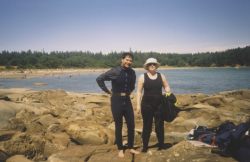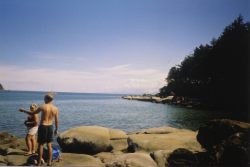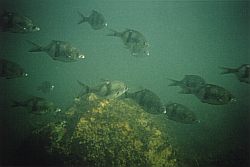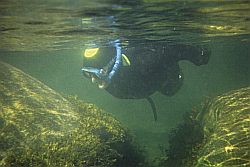Access: Shore dive.
Location: Hornby Island is located off the East coast of Vancouver Island between Parksville and Courtenay. To get there, take the ferry from Buckley Bay to Denman Island, drive across Denman and take another ferry to Hornby Island. Tribune Bay is the largest sandy beach on the island. The bay is divided into two by a sandstone peninsula. This peninsula is the best place for snorkeling and shallow freediving. To get there, drive across the island from the ferry terminal to the Co-op and turn left at the four-way stop. After a short while you’ll see a sign to Tribune Bay Park. Once at the beach, the sandstone peninsula will be on your right.
 |
 |
| Gearing up on the rocks | Best snorkeling at the end of this point |
What you’ll find: The peninsula between Big Tribune and Little Tribune is covered with wild standstone formations, giving it an otherworldly appearance. These formations extend into the water. The sandy beach makes for pretty shallow snorkeling until you get close to the end of the peninsula. The end of the peninsula is the best for snorkeling and freediving and the maximum depth is 30 feet or less. There are lots of boulders and overhangs to look for fish. Things you will see include kelp greenling, perch, the odd lingcod and maybe an octopus. There are also kelp crabs, ochre stars, and sea urchins. Dogfish come around at night and hang out just below the thermocline.
In the summer, the water can get warm enough for some to snorkel without a wetsuit. In fact, Little Tribune Bay is a clothing optional beach so some people go snorkeling without anything at all! The sun heats up the sand on the beach. When the tide comes in, the sand heats up the water.
 |
 |
| School of pile perch | Snorkeling amongst the sandstone boulders |
Hazards: Tribune bay is a popular anchorage in the summer and therefore gets lots of boat traffic. There are lots of small boats with outboard motors, kayaks and inflatable dinghys. Visibility can get quite bad in the summer but at times it can be surprisingly good. Unfortunately, good visibility usually means that the warm surface layer has been blown away.
Submitted by Tom Lightfoot.
